On This Page:
David Kolb published his learning styles model in 1984, from which he developed his learning style inventory.
Kolb’s experiential learning theory works on two levels: a four-stage cycle of learning and four separate learning styles. Much of Kolb’s theory is concerned with the learner’s internal cognitive processes.
Kolb states that learning involves the acquisition of abstract concepts that can be applied flexibly in a range of situations. In Kolb’s theory, the impetus for the development of new concepts is provided by new experiences.
“Learning is the process whereby knowledge is created through the transformation of experience” (Kolb, 1984, p. 38).
The Experiential Learning Cycle
Kolb’s experiential learning style theory is typically represented by a four-stage learning cycle in which the learner “touches all the bases”:
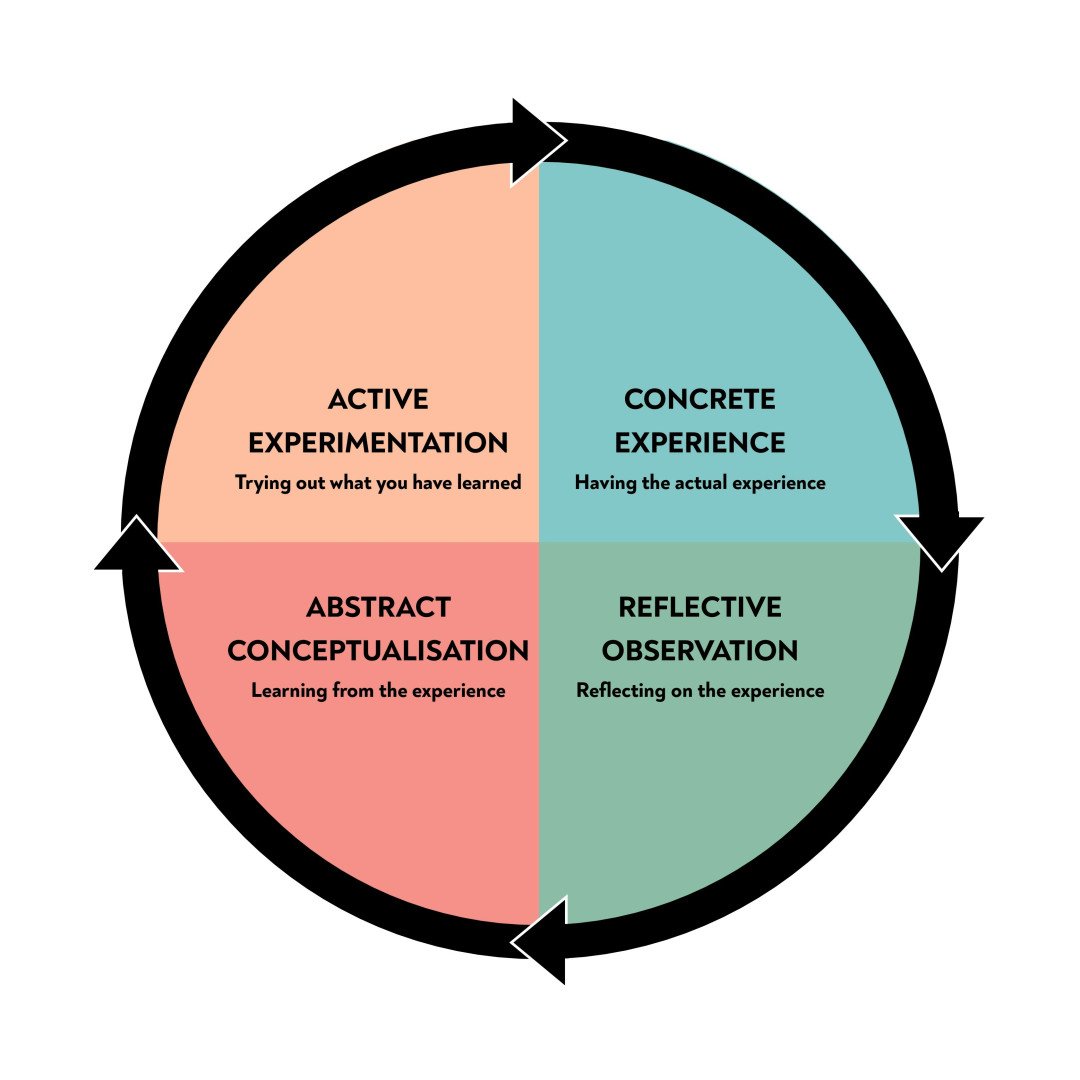
- Concrete Experience – the learner encounters a concrete experience. This might be a new experience or situation, or a reinterpretation of existing experience in the light of new concepts.
- Reflective Observation of the New Experience – the learner reflects on the new experience in the light of their existing knowledge. Of particular importance are any inconsistencies between experience and understanding.
- Abstract Conceptualization – reflection gives rise to a new idea, or a modification of an existing abstract concept (the person has learned from their experience).
- Active Experimentation – the newly created or modified concepts give rise to experimentation. The learner applies their idea(s) to the world around them to see what happens.
Effective learning is seen when a person progresses through a cycle of four stages: of (1) having a concrete experience followed by (2) observation of and reflection on that experience which leads to (3) the formation of abstract concepts (analysis) and generalizations (conclusions) which are then (4) used to test a hypothesis in future situations, resulting in new experiences.
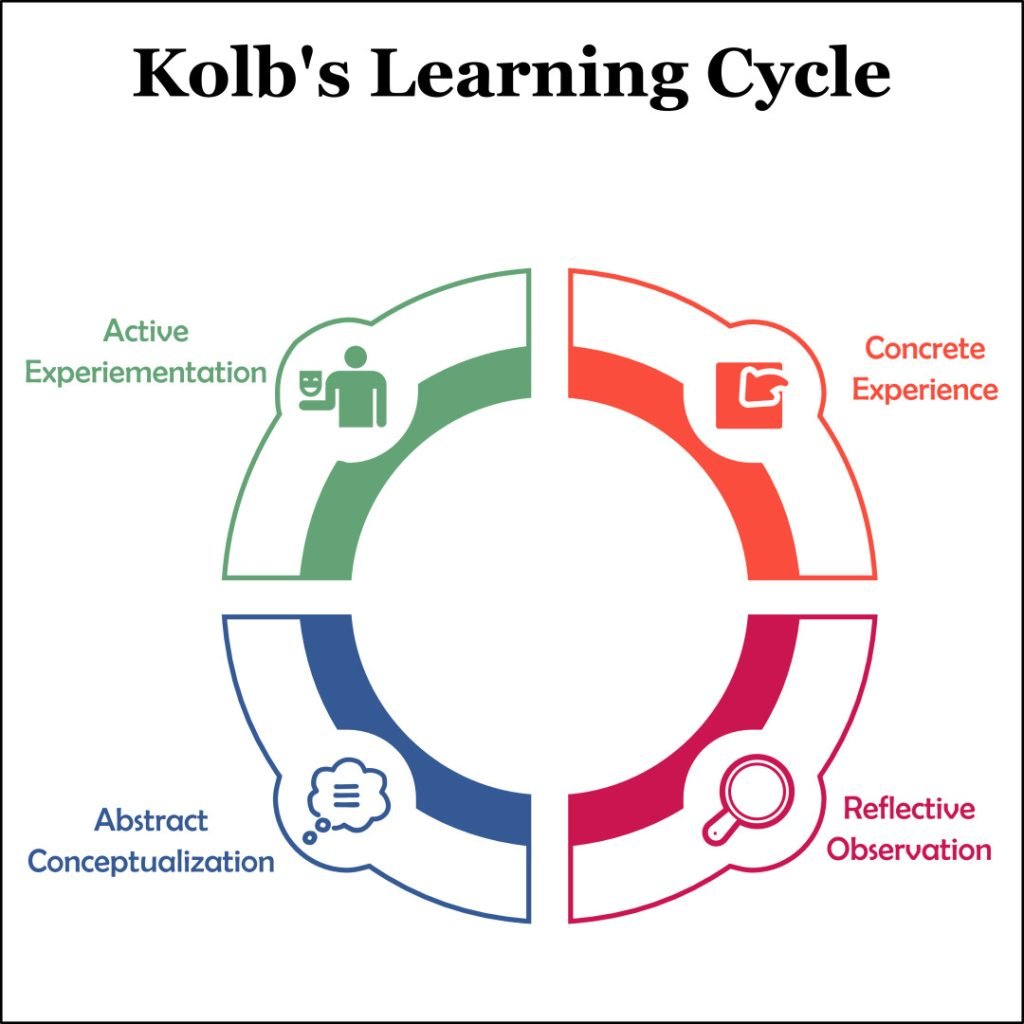
Kolb (1984) views learning as an integrated process, with each stage mutually supporting and feeding into the next. It is possible to enter the cycle at any stage and follow it through its logical sequence.
However, effective learning only occurs when a learner can execute all four stages of the model. Therefore, no one stage of the cycle is effective as a learning procedure on its own.
The process of going through the cycle results in the formation of increasingly complex and abstract ‘mental models’ of whatever the learner is learning about.
Kolb’s Reflective Cycle
Kolb’s learning theory (1984) sets out four distinct learning styles, which are based on a four-stage learning cycle (see above). Kolb explains that different people naturally prefer a certain single different learning style.
Various factors influence a person’s preferred style. For example, social environment, educational experiences, or the basic cognitive structure of the individual.
Whatever influences the choice of style, the learning style preference itself is actually the product of two pairs of variables, or two separate “choices” that we make, which Kolb presented as lines of an axis, each with “conflicting” modes at either end.
A typical presentation of Kolb’s two continuums is that the east-west axis is called the Processing Continuum (how we approach a task), and the north-south axis is called the Perception Continuum (our emotional response, or how we think or feel about it).
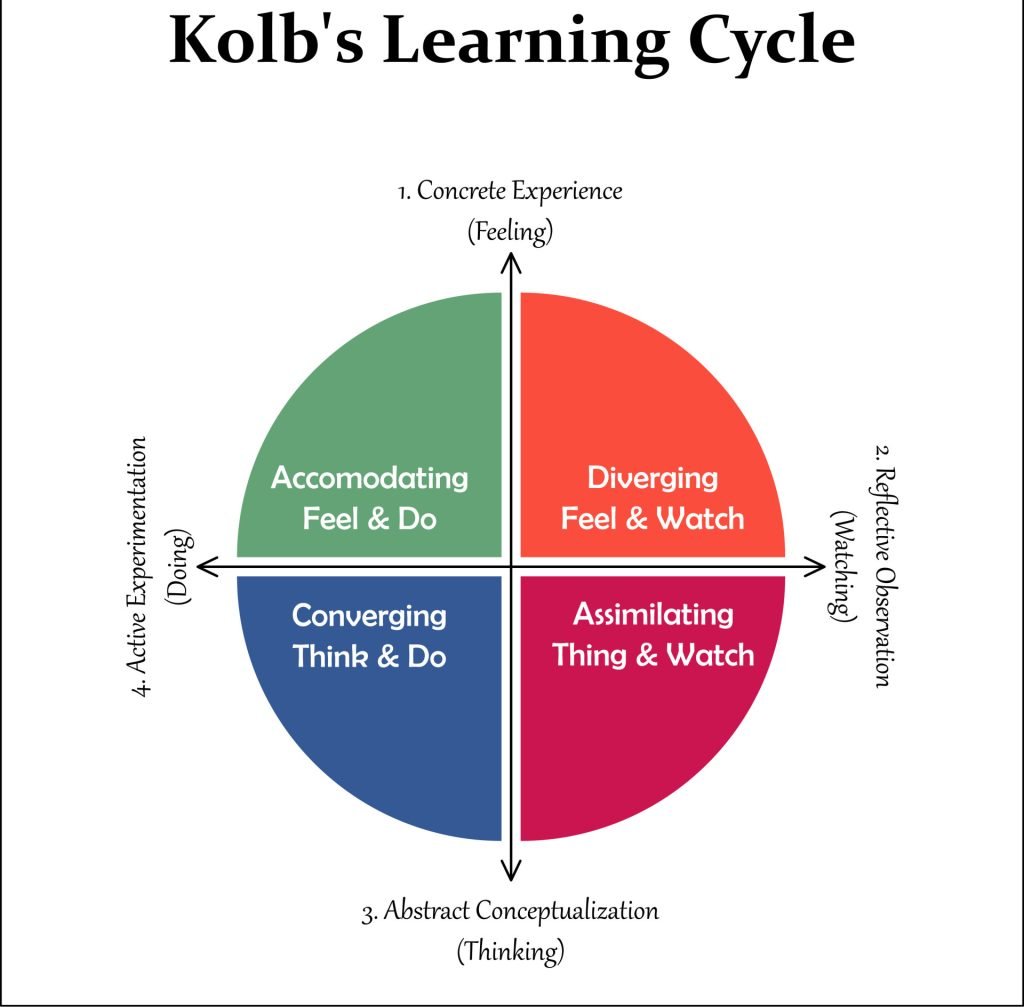
Kolb believed that we cannot perform both variables on a single axis at the same time (e.g., think and feel). Our learning style is a product of these two choice decisions.
It’s often easier to see the construction of Kolb’s learning styles in terms of a two-by-two matrix. Each learning style represents a combination of two preferred styles.
The matrix also highlights Kolb’s terminology for the four learning styles; diverging, assimilating, and converging, accommodating:
| Active Experimentation (Doing) | Reflective Observation (Watching) | |
|---|---|---|
| Concrete Experience (Feeling) | Accommodating (CE/AE) | Diverging (CE/RO) |
| Abstract Conceptualization (Thinking) | Converging (AC/AE) | Assimilating (AC/RO) |
Learning Styles Descriptions
Knowing a person’s (and your own) learning style enables learning to be orientated according to the preferred method.
That said, everyone responds to and needs the stimulus of all types of learning styles to one extent or another – it’s a matter of using emphasis that fits best with the given situation and a person’s learning style preferences.
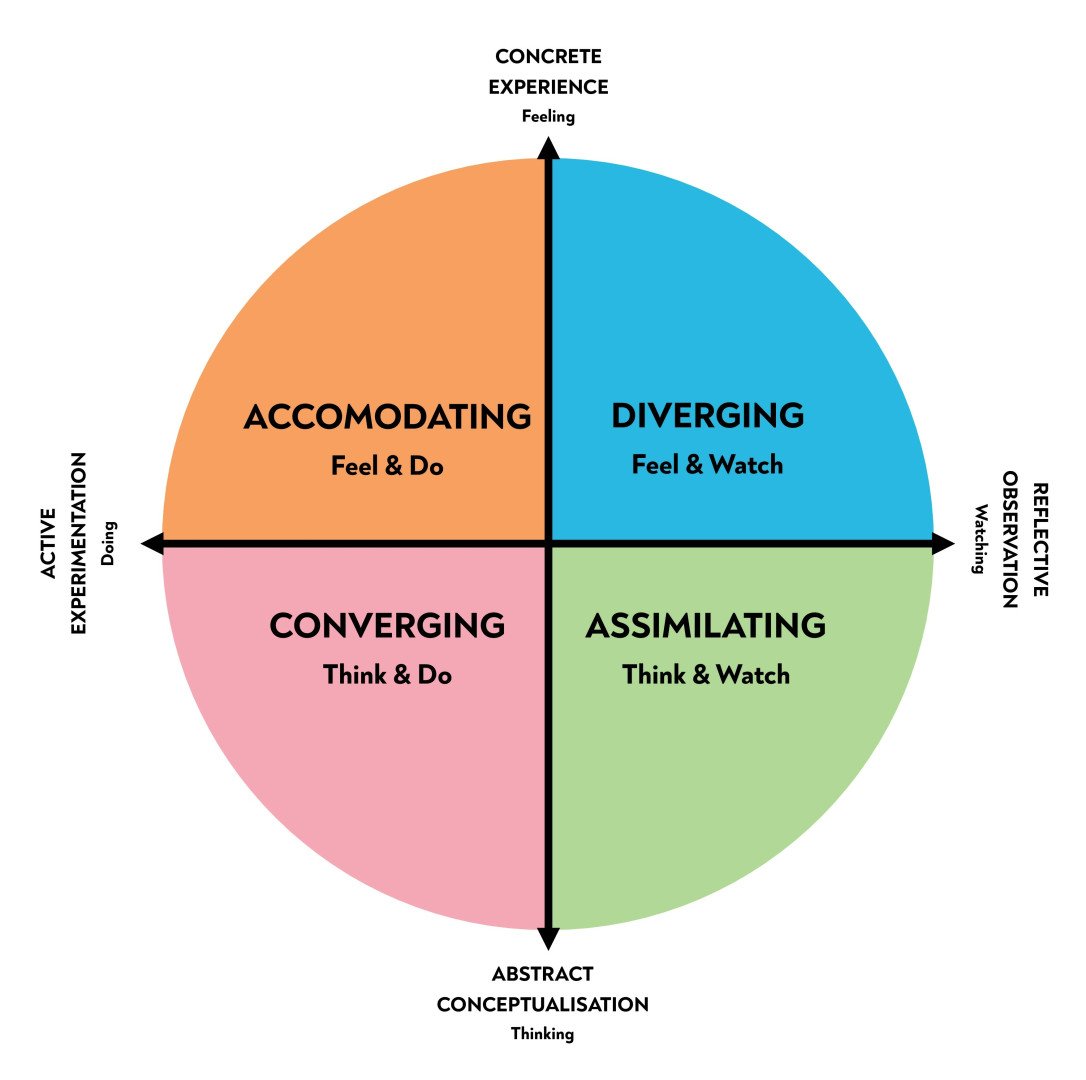
Here are brief descriptions of the four Kolb learning styles:
Diverging (feeling and watching – CE/RO)
These people are able to look at things from different perspectives. They are sensitive. They prefer to watch rather than do, tending to gather information and use imagination to solve problems. They are best at viewing concrete situations from several different viewpoints.
Kolb called this style “diverging” because these people perform better in situations that require ideas-generation, for example, brainstorming. People with a diverging learning style have broad cultural interests and like to gather information.
They are interested in people, tend to be imaginative and emotional, and tend to be strong in the arts. People with the diverging style prefer to work in groups, to listen with an open mind and to receive personal feedback.
Assimilating (watching and thinking – AC/RO)
The assimilating learning preference involves a concise, logical approach. Ideas and concepts are more important than people.
These people require good clear explanations rather than a practical opportunity. They excel at understanding wide-ranging information and organizing it in a clear, logical format.
People with an assimilating learning style are less focused on people and more interested in ideas and abstract concepts. People with this style are more attracted to logically sound theories than approaches based on practical value.
This learning style is important for effectiveness in information and science careers. In formal learning situations, people with this style prefer readings, lectures, exploring analytical models, and having time to think things through.
Converging (doing and thinking – AC/AE)
People with a converging learning style can solve problems and will use their learning to find solutions to practical issues. They prefer technical tasks, and are less concerned with people and interpersonal aspects.
People with a converging learning style are best at finding practical uses for ideas and theories. They can solve problems and make decisions by finding solutions to questions and problems.
People with a converging learning style are more attracted to technical tasks and problems than social or interpersonal issues. A converging learning style enables specialist and technology abilities.
People with a converging style like to experiment with new ideas, to simulate, and to work with practical applications.
Accommodating (doing and feeling – CE/AE)
The Accommodating learning style is “hands-on,” and relies on intuition rather than logic. These people use other people’s analysis, and prefer to take a practical, experiential approach. They are attracted to new challenges and experiences, and to carrying out plans.
They commonly act on “gut” instinct rather than logical analysis. People with an accommodating learning style will tend to rely on others for information than carry out their own analysis. This learning style is prevalent within the general population.
Educational Implications
Both Kolb’s (1984) learning stages and the cycle could be used by teachers to critically evaluate the learning provision typically available to students, and to develop more appropriate learning opportunities.
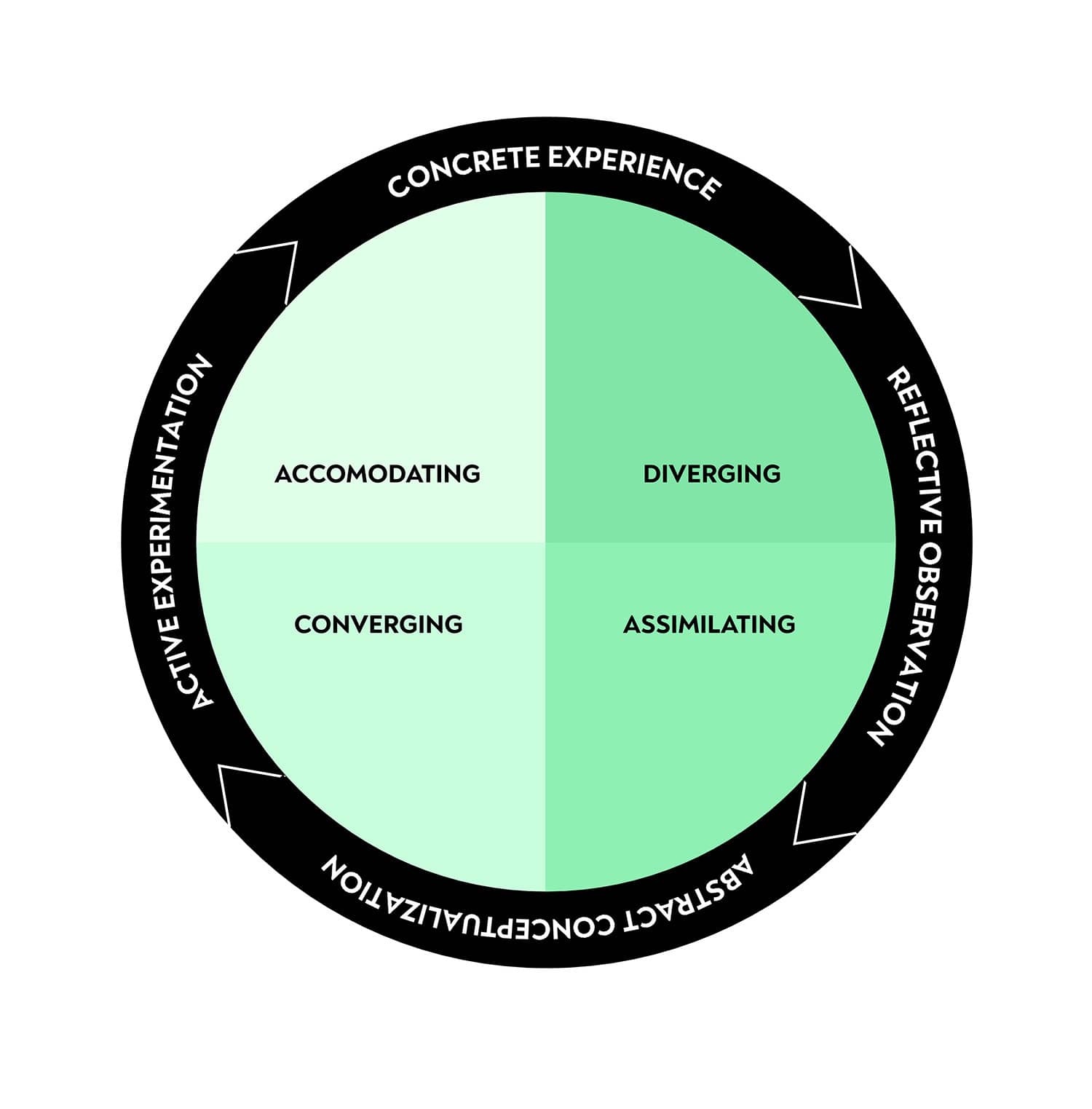
Educators should ensure that activities are designed and carried out in ways that offer each learner the chance to engage in the manner that suits them best.
Also, individuals can be helped to learn more effectively by the identification of their lesser preferred learning styles and the strengthening of these through the application of the experiential learning cycle.
Ideally, activities and material should be developed in ways that draw on abilities from each stage of the experiential learning cycle and take the students through the whole process in sequence.
References
Kolb, D. A. (1976). The Learning Style Inventory: Technical Manual. Boston, MA: McBer.
Kolb, D.A. (1981). Learning styles and disciplinary differences, in: A.W. Chickering (Ed.) The Modern American College (pp. 232–255). San Francisco, LA: Jossey-Bass.
Kolb, D. A. (1984). Experiential learning: Experience as the source of learning and development (Vol. 1). Englewood Cliffs, NJ: Prentice-Hall.
Kolb, D. A., & Fry, R. (1975). Toward an applied theory of experiential learning. In C. Cooper (Ed.), Studies of group process (pp. 33–57). New York: Wiley.
Kolb, D. A., Rubin, I. M., & McIntyre, J. M. (1984). Organizational psychology: readings on human behavior in organizations. Englewood Cliffs, NJ: Prentice-Hall.

